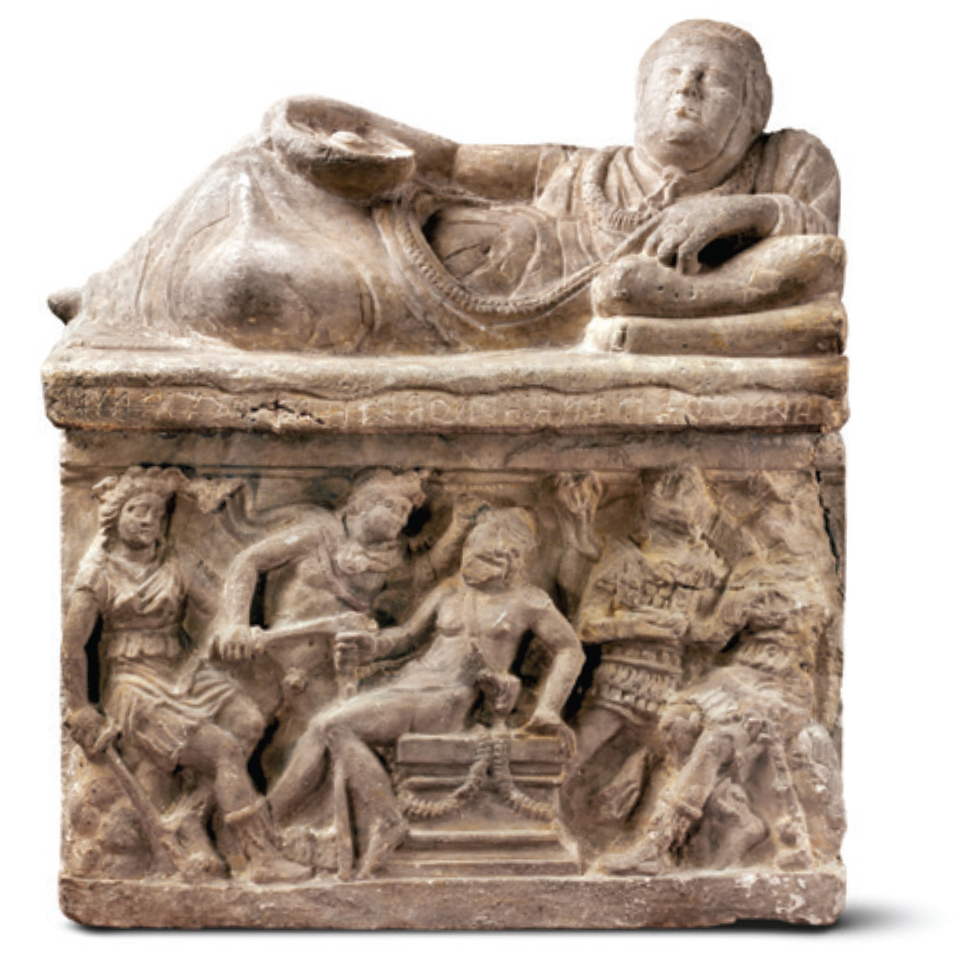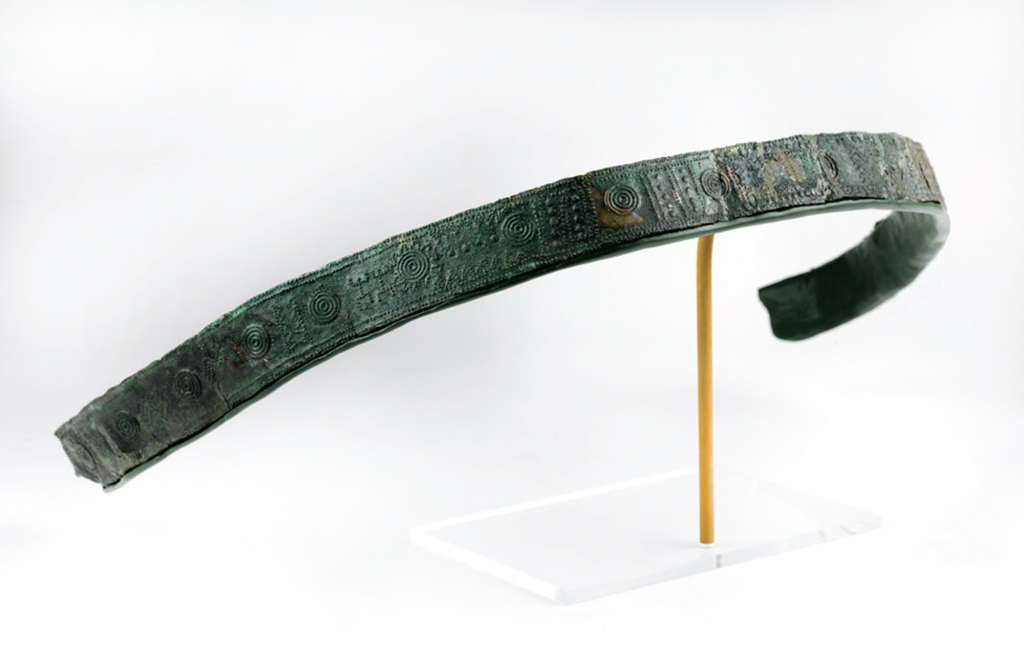A depiction of a comet may have been discovered on an artifact in the Museum’s Etruscan collection. This rare narrative artwork tells the story of people trying to make sense of astronomical events. Far from unusual, the ancients left behind many artifacts and images that tell us they were observing the skies as much as we do today.
The Etruscan Brontoscopic Calendar (ca. 8th to 7th centuries BCE) was circulated in the 1st century BCE by Publius Nigidius Figulus, a friend of Cicero whose Etruscan ancestry led him to translate an archaic Etruscan religious text into Latin for his contemporaries to study.
It predicts an uncommon omen for May 27: “If it thunders, there shall be prodigies, and a comet shall shine forth.” And on May 28: “If it thunders, it shall be the same.”

Comets were rare apparitions for ancient observers, understood as special messengers from the gods, like the comet that appeared during the funeral games for the assassinated Julius Caesar. His heir, Octavian, circulated special coins depicting it as a sign of Caesar’s deification. Mithradates VI, charismatic enemy of Rome, would commemorate his birth in 135/134 BCE with coins depicting the great comet that blazed that year, and another that appeared in 119 BCE when he took the throne of Pontus. The Star of Bethlehem, depicted by Giotto in the Nativity scene in the Arena Chapel, Padua (1305), is another comet-harbinger. In modern times Halley’s Comet was remarked on by authors like Mark Twain and commemorated with all sorts of memorabilia.

e Lombardia, by Umberto Sansoni.
Comets have inspired art as well as literature. Many diverse cultures have been fascinated with—and at- tempted to discover meaning in—comets. In the north of Italy in the Final Bronze to Iron Age (ca. 1000 BCE), unnamed artists carved what looks like a comet with two curved tails on the outcrop of Rock 35 in the Valcamonica region, near what is today Nadro di Ceto, Brescia, Italy. The simple figure seems similar, though unrelated, to two-tailed comets illustrated in the beautiful Silk Texts from Tomb 3 at Mawangdui (Hunan, China). Sealed into a royal tomb in 168 BCE, they furnish an illustrated typology of comets seen over China and linked with specific omens.



A Bronze Belt in the Museum Collection
A slim sheet-bronze belt buried with an Etruscan noble-woman in the 7th century BCE and now in the Etruscan Gallery in the Penn Museum may feature a comet or two in a very rare narrative scene depicted in repoussé, the technique of hammering a raised pattern up from the back surface of a metal sheet. In fact, a set of bronze belts—confining to wear and probably only used for ceremonial costumes—had been placed in Vulci Tomb 42F, along with a cinerary urn (its contents not preserved), 22 ceramic vases, and a pair of roasting spits fashioned to imitate spears, perhaps symbolic of the deceased presiding at banquets as hostess for a warrior husband. Today a green patina obscures their surfaces but in antiquity they would have been brightly polished and golden in color, with fine leather backing. One of the two belts is in the preferred lozenge-shape, decorated with punched horses, an aristocratic symbol. The second narrow, ribbon-like belt has round bosses with raised concentric circles and textile-like patterns of dots and lines as borders, but one end, with the hook to fasten the belt, has a starburst boss and two tiny stick figures with arms akimbo—representing humans who gesture in awe, fear, or jubilation.
The combination of images, read from right to left as ancient Etruscans read their language, tells a story. At the beginning, at the wearer’s left side, the starburst is linked to a plain boss by opposing zigzag lines that look suspiciously like Egyptian symbols for water, known in Etruria from Egyptian-inspired gold work brought by the Phoenicians. Following the humans, a pair of bosses frame two upright, opposed water-signs, and in the last portion of the story, on the far end of the belt, are two bosses each with a set of parallel, hooked rays fanning out toward the men. If the first boss behind the people is the sun, surely the last two are comets; the final boss has thin lines emanating from it like light rays. Perhaps the plainer, interim boss relates to the omen of a comet that “shall be the same,” in other words a second day’s appearance of the cosmic visitor, or possibly the sort of blazing meteor that can be thrown off by a passing comet.


Narrative scenes with human figures are extremely rare in the art of Iron Age central Italy; their production must have been inspired by some special circumstance or commission. Likewise, while known from female burials at Narce and Veii, the ribbon-like belt form, so familiar to us, is uncommon in the costume of archaic Etruria. Curiously, Halley’s comet passed by Earth in 695 BCE; the lady of Vulci Tomb 42F was alive then, and probably only buried around 680 BCE or later. The design of the Halley’s Comet apparition in the Bayeux Tapestry, presaging the demise of the Saxon kingdom in 1066, looks a bit like the belt’s images. Did the visit of Halley’s Comet represent a significant place in her life, or might she have been a priestess involved in divination of such events? Even the repeating imagery might relate to the omen of “same again.” In the absence of Etruscan literature, we cannot know the answers. No written records are known for the comet of 695 BCE, although Chinese astronomers documented later visits. In addition, a Babylonian cuneiform tablet from 168–164 BCE now in the British Museum is believed to record a sighting of Halley’s. It seems that the collection of Etruscan tomb groups excavated for the Penn Museum in the 1890s still holds some surprises for us today.Ä

Note: An earlier report on this discovery appeared in the winter 2018 issue of Etruscan News.
JEAN MACINTOSH TURFA, PH.D., is a specialist in Etruscan art and archaeology and Consulting Scholar in the Mediterranean Section at the Penn Museum.
For Further Reading
Dohan, E.H., Italic Tomb Groups in the University Museum. Philadelphia: University of Pennsylvania Press, 1942, pp. 93–97, pls. 49–50.
Turfa, J.M., Catalogue of the Etruscan Gallery. Philadelphia: University of Pennsylvania Museum, 2005, pp. 100–103.
Turfa, J.M., Divining the Etruscan World. The Brontoscopic Calendar and Religious Practice. Cambridge: Cambridge University Press, 2012.



